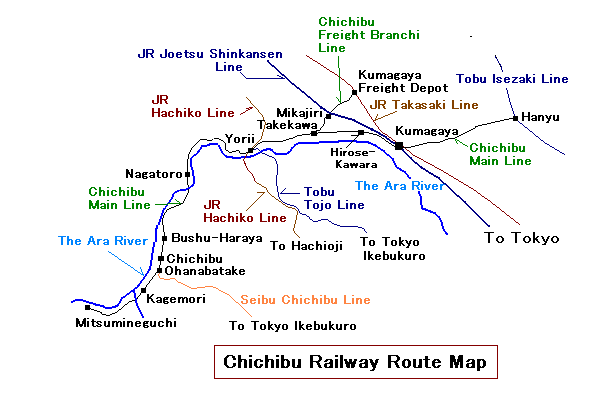

Chichibu Railway |
| Its attraction is nostalgic steam and busy freight work. |
| Page 1 |
| History and Background |
 |
 |
| Steam engine C58-363 (2-6-2) leads "Paleo Express," west of Yorii |
Chichibu busily operates hopper freight trains. |
General:
The Chichibu Railway is a regional railway that runs 71.7km between
Hanyu and Mitsumineguchi across northern Saitama prefecture, just north
of the Tokyo metropolitan area, from east to west. It intersects with
the Joetsu Shinkansen and the conventional Takasaki Line at Kumagaya,
about 65 km north of Tokyo and 15 km west of Hanyu, where it connects
to the Tobu Isezaki Line.

This regional railway was so named because its western end serves the
Chichibu district. Chichibu, quietly situated at the foot of the
Chichibu mountain range, is known as a historical town whose prosperity
dates back to several hundred years because of its silk textile
industry. Another factor in its fame is its cement industry, thanks to
the rich limestone resources in Mt. Buko, located just south of
Chichibu City. Mitsumineguchi (guchi
means "entrance"), the western terminus of the line, is the access
point for Mt. Mitsumine, known for the more than 1000-year-old
Mitsumine Shrine located deep in a Japanese cedar forest near its
summit, and also as the starting point for mountaineering in the inner
Chichibu range. There is also a tourist spot along the main line at
Nagatoro Gorge, which attracts sightseers with its beautiful canyon
lined with abundant greenery on both banks. Thus, the Chichibu Railway
plays three roles: as a commuter service over the eastern segment
linking Kumagaya (Yorii-Kumagaya-Hanyu), as a freight transportation
service and as a tourist railway service.
 |
| Deki-108, at Kumagaya. |
 |
| The freight hauling fleet resting at Hirosekawara depot. |
 |
| Oki-100 and Okifu-100 hoppers at Hirosekawara depot. |
The line consists entirely of single track on 1,067 narrow gauge with
31 interlocking stations including both terminals and five
non-interlocking stations. It is fully signaled with automatic blocking
systems along with an automatic train stopping (ATS) system. The
traffic is entirely controlled through a centralized traffic control
(CTC) system.
The railway's main line looks like single line crossing over the two JR
trunk lines at Kumagaya, but the passenger traffic splits into two
different flows on the eastern and western segments across Kumagaya.
Although the railway is a normal passenger line served by EMUs, it
attracts railway enthusiasts due to its two distinctive features: busy
freight operations and steam trains.
The Chichibu Railway cannot be mentioned without referring to
Chichibu-Onoda Co. (established in 1994 through a merger between
Chichibu Cement Co. and Onoda Cement Co.). Since the foundation of
Chichibu Cement Co. in 1923 to utilize the limestone resources on Mt.
Buko, the company has been deeply involved with the Chichibu Railway in
terms of both capital and corporate officers. Chichibu-Onoda is still
the top stockholder of Chichibu Railway Co.
Freight Operation:
The railway's freight operations take place between Kagemori and
Kumagaya freight depot on the JR Takasaki Line reached from Takekawa
station through a freight branch line (7.6 km). On the main line there
are four freight yards, at Hirosekawara, Bushu-Haraya, Chichibu and
Kagemori. There used to be a short freight branch from Kagemori to
Buko, but it was abolished in 1984 when a belt conveyer system was put
into service between Mt. Buko and Nippon Cement's Saitama Plant.
Chichibu's freight hauling fleet consists of 21 50-ton class electric
locomotives. There are eight Deki-100s, three Deki-200s, three
Deki-300s and seven Deki-500s, built by Hitachi in 1951, 1963, 1967 and
1973, respectively. The railway also owns a number of freight cars,
comprising over one hundred hoppers and some tens of
brakeman-cabin-equipped hoppers.
Chichibu's freight operations are the busiest among non-JR private
railways in Japan. The freight operations mostly consist of limestone
transportation between Kagemori and the Mikajiri freight depot on the
branch line, where a Chichibu-Onoda cement complex is located, and
cement trains between Chichibu and the JR Kumagaya freight depot, with
each making about 15 round trips a day.
 |
 |
| C58-363 pulling out of Minano station. | Down-bound Paleo Express on the longest bridge of Chichibu Railway over the Ara River. |
The information and data were taken from "Chichibu Tetsudo" by Kazuaki Sawauchi in the Railway Pictorial No. 260 (April 1996 special edition).